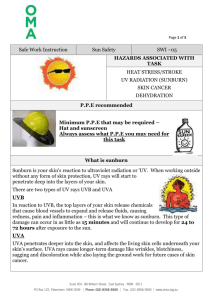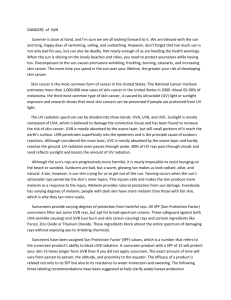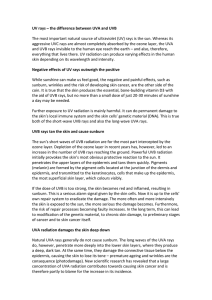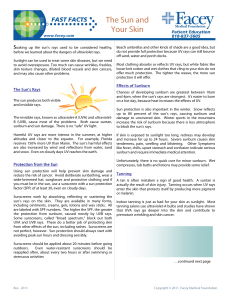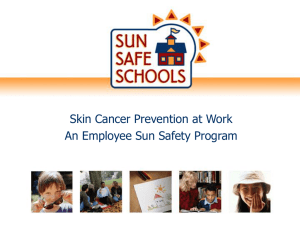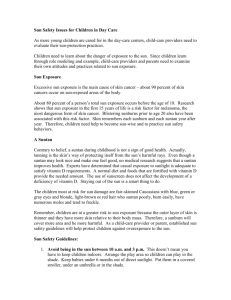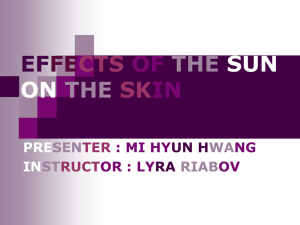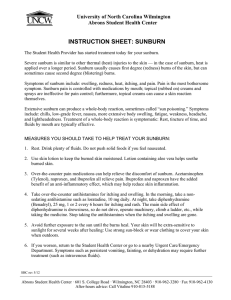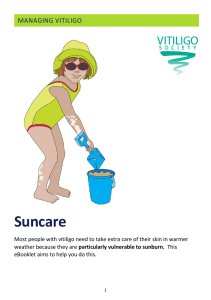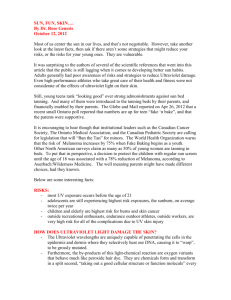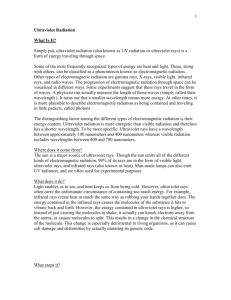Following an incident where a service user has sustained sun burn
advertisement
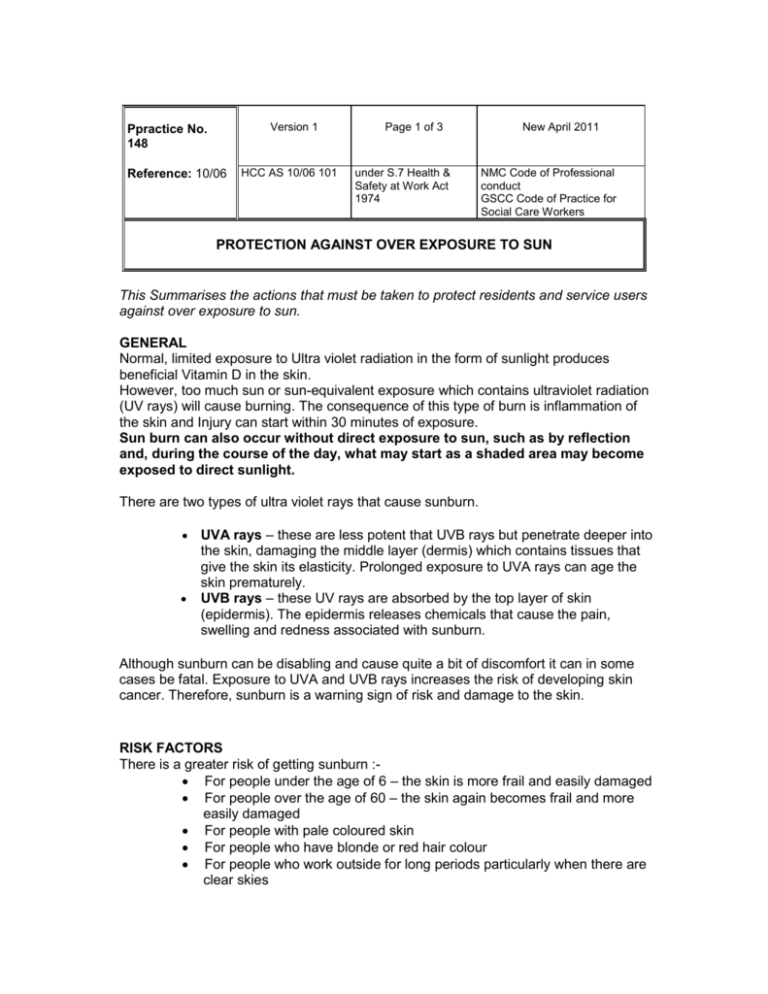
Version 1 Ppractice No. 148 Reference: 10/06 HCC AS 10/06 101 Page 1 of 3 under S.7 Health & Safety at Work Act 1974 New April 2011 NMC Code of Professional conduct GSCC Code of Practice for Social Care Workers PROTECTION AGAINST OVER EXPOSURE TO SUN This Summarises the actions that must be taken to protect residents and service users against over exposure to sun. GENERAL Normal, limited exposure to Ultra violet radiation in the form of sunlight produces beneficial Vitamin D in the skin. However, too much sun or sun-equivalent exposure which contains ultraviolet radiation (UV rays) will cause burning. The consequence of this type of burn is inflammation of the skin and Injury can start within 30 minutes of exposure. Sun burn can also occur without direct exposure to sun, such as by reflection and, during the course of the day, what may start as a shaded area may become exposed to direct sunlight. There are two types of ultra violet rays that cause sunburn. UVA rays – these are less potent that UVB rays but penetrate deeper into the skin, damaging the middle layer (dermis) which contains tissues that give the skin its elasticity. Prolonged exposure to UVA rays can age the skin prematurely. UVB rays – these UV rays are absorbed by the top layer of skin (epidermis). The epidermis releases chemicals that cause the pain, swelling and redness associated with sunburn. Although sunburn can be disabling and cause quite a bit of discomfort it can in some cases be fatal. Exposure to UVA and UVB rays increases the risk of developing skin cancer. Therefore, sunburn is a warning sign of risk and damage to the skin. RISK FACTORS There is a greater risk of getting sunburn : For people under the age of 6 – the skin is more frail and easily damaged For people over the age of 60 – the skin again becomes frail and more easily damaged For people with pale coloured skin For people who have blonde or red hair colour For people who work outside for long periods particularly when there are clear skies At a high altitude – for example, climbing or skiing Near snow, ice or water where the sun’s rays can reflect onto the skin During the use of certain drugs which can sensitize the skin to radiation injury. In these cases over exposure to sun should be avoided, and if necessary medical advice sought. The most likely medications to cause sun sensitivity are antibiotics, antipsoriatics (prescribed for skin conditions), and acne medicines. Some anti-inflammatory medications may also have this effect. The herbal drug, St. John's Wort, is also thought to make skin more vulnerable to sunburn People with reduced awareness to the environment e.g. during the use of mind-altering drugs (including alcohol) SUNBURN SYMPTOMS Mild and uncomplicated cases of sunburn usually result in minor skin redness and irritation Sufficient exposure can become very painful Untreated burns and excessive exposure, can result in shock (poor circulation to vital organs) and even death Initially, the skin turns red about 2-6 hours after exposure and feels irritated. The peak effects are noted at 12-24 hours In more severe cases there can be severe skin burning and blistering, massive fluid loss resulting in dehydration, electrolyte (body fluid chemical) imbalance, and infection Other common symptoms include: Chills Fever Nausea and vomiting Influenza like symptoms Blistering – which may range from a very fine blister that is only found when the skin begins to "peel", to very large water filled blisters with red, tender, raw skin underneath Skin loss - About 4-7 days after exposure PREVENTION The best prevention is to avoid the sun. Other, more practical strategies include : Wearing wide-brimmed hats, long-sleeved shirts, and long trousers Using a sun-blocking agent. Some are just for the lips and face, others are for more general-purpose use. Attention must be paid to the sun protection factor (SPF) and whether or not PABA is in the product. PABA should be avoided in persons with frail or sensitive skin as it can cause skin irritation. The higher the SPF number, the more protection the sunblocking agent may have. SPF is actually a ratio of the time it takes to produce a skin reaction on protected and unprotected skin. Thus, a 30 SPF sunscreen would in theory allow exposure 30 times longer than with no sunscreen. However, this may vary in practice and should not be relied on. Sunscreen must be applied in generous amounts, in layers and reapplied as necessary. Activities such as sweating and swimming degrade its effectiveness. Sunscreens are not waterproof. N.B. These preparations are Screening substances, THEY DO NOT BLOCK harmful radiation. ESSENTIAL ACTION AND RECORDING A generic risk assessment must be in place relating to :the use of sun screen and the frequency of application to exposed skin, protective clothing to be worn e.g. wide brimmed hats, light covering for arms and legs Individual risk assessments, where necessary, relating to specific medication or health conditions which contra indicate or require specific treatment before exposure to sun, e.g. taking Ibuprofen based medication/ steroids etc. The manager in consultation with the key worker should access BNF online if unsure, and/or contact the supplying pharmacy or GP practice. Staff must ensure that they record the actions taken before a resident or service user sits in the sun STAFF Staff are not exempt from the risk of sun burn and all staff have a duty of care to protect the health and welfare of themselves and others, under S.7 of the Health & Safety at Work Act 1974. When working with residents and service users where there is a risk of sunburn, staff are strongly advised to apply a level of care to themselves as that of the people they are working with, by wearing suitable clothing – within the dress code – see guide line 101, and using sunscreen as appropriate.
